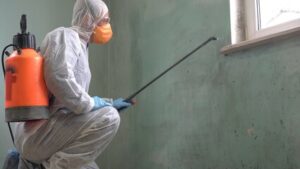Replacing your roof is a big investment, but it will protect your home, add value and give you peace of mind for decades to come. Whether you need to repair or replace, it’s important to make the right decision now to avoid costly damage down the road.

Localized damage resulting from recent storms or isolated shingle issues typically call for repairs. More extensive damage across large sections of your roof compromises structural integrity and requires a full replacement. Contact Roof Repair La Vergne TN for professional help.
Damaged shingles are among the most common roof repair issues. The structural integrity of your roof is compromised if moisture can get in through damaged shingle areas, which can lead to leaks and interior damage. Handling shingle repairs promptly is essential to ensure your home’s resilience against future severe weather events.
Shingles can be damaged by high winds, hail or normal wear and tear. A thorough roof inspection can identify shingle issues, including bald spots and blisters, which are signs that the shingle has reached the end of its lifespan and needs to be replaced.
In addition to checking shingles, you should also inspect the flashing around chimneys, vents and skylights for looseness or corrosion. Inspect the soffit, too, where it meets the roof. Cracks in the soffit or a leaking roof deck can lead to water penetration through shingle areas and other areas of the roof, which may require a full roof replacement.
Signs of shingle damage include distorted, missing or curled shingles, which can leave your roof vulnerable to leaks. You can sometimes restore shingle damage by overlapping undamaged shingles and resealing them, but this is a temporary fix that should be replaced with a complete roof replacement when the time comes.
You should also be on the lookout for granules on the ground, which indicate that your shingles are losing their protective layer and need to be replaced. Also pay attention to the color of your shingles; dark gray or black granules indicate that the shingle is nearing the end of its lifespan and should be replaced immediately.
The deterioration of your shingles can also be caused by extreme heat or cold, which can cause them to curl or flatten. If your shingles are showing these signs of aging, you should call for a roof repair as soon as possible to prevent further damage and potential leaks.
Leaks caused by shingle damage are one of the most common roof repair issues, and it is important to address them quickly to protect your investment and secure your living space. Leaving these problems unattended can lead to costly water damage, and they can also compromise the energy efficiency of your home and lead to increased utility bills.
Leaking Gutters
Gutters are necessary to catch roof runoff and channel it away from the house, but poorly functioning gutters can cause damage. If a gutter becomes clogged or has leaks, it can lead to basement flooding, water staining and mold growth, and even structural damage. The solution is simple: have your gutters repaired or replaced.
When a gutter leaks, it’s usually because the seams and joints have separated. These problems are easily repairable and can be done with a gutter sealant or patch kit. It is also important to inspect and clean your gutters on a regular basis to prevent the buildup of leaves and debris that can lead to clogs.
The fasteners that hold your gutters to the fascia boards can loosen over time, especially if the materials are older and have become warped from exposure to the elements. This can cause the gutters to shift and create holes, which is another common source of leaking gutters. A roofing contractor can retighten these fasteners and seal the gaps to ensure the gutters are properly secured.
Another common problem with gutters is that they can be disconnected from the downspouts due to missing or torn-out screws. This can result in water pouring out of the gutters or down over the sides of the house, which can cause shingle damage and even leak into the walls of the home.
When your gutters are leaking, it is important to have them fixed as soon as possible to avoid costly repairs in the future. It is also important to have roofing experts inspect your gutters on a regular basis to ensure the fasteners are secure and that the gutters are free from any clogs or leaks. By having your gutters inspected and repaired regularly, you can reduce the risk of major damage to your home or business that may require thousands of dollars in repairs.
Damaged Flashing
Flashing is a thin layer of waterproof material used around openings in the roof, such as skylights, chimneys, vent pipes, and dormers. It prevents moisture from seeping into the home and causing damage to the ceiling, walls, and structural members. Flashing is usually made from rust-resistant metal, such as galvanized steel. Depending on the application, it can be installed in a variety of ways. For example, step flashing is used where a vertical surface meets a sloping roof and is formed from pieces that overlap each other. Continuous flashing is a long piece of metal that protects the joint between a wall and a roof, while drip edge flashing is installed along the roof edges to help direct water into the gutters.
The most common sign of flashing damage is a visible crack or gap. This may be caused by aging, exposure to the elements, or improper installation. A gap in the flashing will allow water to infiltrate the roof, causing extensive and costly damage. It is important to regularly inspect the flashing and take prompt action if any signs of damage are observed.
If you notice signs of damaged flashing, it is recommended that you contact a professional roofer for a permanent repair. However, if the damage is minor or isolated, temporary fixes can be undertaken to prevent further issues. For example, a sealant can be applied to any visible cracks or gaps in the flashing.
When performing a DIY flashing repair, it is important to wear appropriate safety gear and use a ladder that is in good condition. The most important step is to identify the problem area and carefully remove any shingles or other roofing materials that cover or overlap the flashing. After the old flashing has been removed, it is important to clean the area thoroughly to remove any traces of corrosion or debris.
Once the area is clean, a new piece of flashing can be cut to size and installed in place. The flashing should be sealed with roof cement or another form of protective sealant to prevent water from infiltrating the roof.
Structural Damage
If the damage extends to the underlying structure, your roof repair may be more extensive than simply replacing missing or damaged shingles. A structural repair may involve reinforcing the damaged area, resealing leaks, or addressing underlying issues like poor ventilation or insulation that contribute to the problem.
The structural integrity of a building depends on the strength and condition of its components, as well as the overall design and construction. Structural problems can emerge from a number of factors, including environmental conditions, overloading, bad construction practices, accidents, or natural disasters like earthquakes and floods. Whatever the cause, a structural defect can compromise the load-bearing capacity of the affected component or structure, leading to reduced stability and possibly even collapse.
Poor materials and workmanship are common causes of structural problems in a home’s roofing system. Insufficient ridge board support, improperly installed flashing, and misaligned shingles can all leave your home vulnerable to leaks and water intrusion. Leaks allow moisture to seep into the building and damage drywall, paint, wallpaper, and furnishings. In severe cases, water can trickle down to the foundation and create serious problems for the entire structure.
It’s important to perform regular inspections and make minor repairs for the long-term health of your roof. A well-maintained roof can last up to 25 years or more. If yours is nearing the end of its lifespan, or if you’re thinking about selling your home anytime soon, a new roof with resilient materials makes sense for resale value.
Many insurance companies cover roof repairs and replacements when they are the result of a covered peril or event. However, damage from neglect or insufficient maintenance often isn’t covered under homeowners’ policies. Whether or not your insurance covers the cost of roof repair depends on your policy coverage limits, specific exclusions, and applicable deductibles.
Even if your home is relatively new, it’s a good idea to repair and replace any damaged components of the roofing system as soon as possible. This will help protect your investment, as well as prevent further problems down the road. Structural issues are a deal-breaker for potential buyers and can affect the sale of your home.




